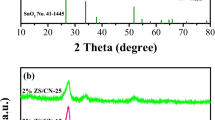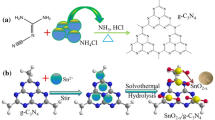Abstract
Considering the high environmental risk, the remediation of antibiotic pollutants attracted numerous attentions. In this work, a novel photocatalyst, Ce0.9Zr0.1O2/SnIn4S8, was fabricated by in situ precipitation and hydrothermal method and then applied to the degradation of norfloxacin under the irritation of visible light. The SEM, TEM, XRD, XPS, and electrochemical results clearly showed that the n-type heterojunction between Ce0.9Zr0.1O2 and SnIn4S8 was successfully constructed, which greatly reduces the recombination of the photogenic electron and holes, leading to the improvement of photocatalytic performance and stability (recycled over eight times). Besides, the Ce0.9Zr0.1O2/SnIn4S8 composite also exhibited good ability to mineralize norfloxacin. Under the optimal condition (pH 3, 1 g L−1 of 10% Ce0.9Zr0.1O2/SnIn4S8, and 8 mg L−1 of initial norfloxacin concentration), norfloxacin could be fully and rapidly degraded in 60 min, and completely mineralized in 4 h (99.3 ± 1.7%). LC-QTOF-MS results evidently displayed eight intermediates during norfloxacin degradation. In addition, with the attack of the reactive oxygen species (h+, •OH, and •O2−), norfloxacin could be effectively decomposed via deoxygenation, hydroxylation, and carboxylation reactions. Notably, compared to photodegradation, the photocatalytic process could completely eliminate the norfloxacin from water because it could avoid the accumulation of toxic byproducts.







Similar content being viewed by others
References
Aggarwal SL, Tilley GP (1955) Determination of crystallinity in polyethylene by X-ray diffractometer. J Polym Sci 18(87):17–26
Ahmed MB, Zhou JL, Ngo HH, Guo W (2015) Adsorptive removal of antibiotics from water and wastewater: progress and challenges. Sci Total Environ 532:112–126
Anderson JA, Fierro J (1994) Bulk and surface properties of copper-containing oxides of the general formula LaZr1-xCuxO3. J Solid State Chem 108:305–313
Baek M, Yoon J, Hong J, Suh J (2013) Application of TiO2-containing mesoporous spherical activated carbon in a fluidized bed photoreactor—adsorption and photocatalytic activity. Appl Catal A-Gen 450:222–229
Carrettin S, Concepción P, Corma A, Nieto JML, Puntes VF (2004) Nanocrystalline CeO2 increases the activity of Au for CO oxidation by two orders of magnitude. Angew Chem Int Ed Eng 43:2538–2540
Chen Y, Tian G, Zhou W, Xiao Y, Wang J, Zhang X, Fu H (2017) Enhanced photogenerated carrier separation in CdS quantum dot sensitized ZnFe2O4/ZnIn2S4 nanosheet stereoscopic films for exceptional visible light photocatalytic H2 evolution performance. Nanoscale 9:5912–5921
Ding C, Tian L, Liu B, Liang Q, Li Z, Xu S, Liu Q, Lu D (2015) Facile in situ solvothermal method to synthesize MWCNT/SnIn4S8 composites with enhanced visible light photocatalytic activity. J Alloys Compd 633:300–305
Ding D, Liu C, Ji Y, Yang Q, Chen L, Jiang C, Cai T (2017) Mechanism insight of degradation of norfloxacin by magnetite nanoparticles activated persulfate: identification of radicals and degradation pathway. Chem Eng J 308:330–339
Fabiańska A, Bia K-Bielińska A, Stepnowski P, Stolte S, Siedlecka EM (2014) Electrochemical degradation of sulfonamides at BDD electrode: kinetics, reaction pathway and eco-toxicity evaluation. J Hazard Mater 280:579–587
Fernandes J, Picciochi R, Belo MDC, E Silva TM, Ferreira M, Fonseca I (2004) Capacitance and photoelectrochemical studies for the assessment of anodic oxide films on aluminium. Electrochim Acta 49:4701–4707
Fornasiero P, Rao GR, Ka Par J, Erario FL, Graziani M (1998) Reduction of NO by CO over Rh/CeO2-ZrO2 catalysts – evidence for a support-promoted catalytic activity. J Catal 175:269–279
Ge L, Chen J, Wei X, Zhang S, Qiao X, Cai X, Xie Q (2010) Aquatic photochemistry of fluoroquinolone antibiotics: kinetics, pathways, and multivariate effects of main water constituents. Environ Sci Technol 44:2400–2405
Gou J, Ma Q, Deng X, Cui Y, Zhang H, Cheng X, Li X, Xie M, Cheng Q (2017) Fabrication of Ag2O/TiO2-Zeolite composite and its enhanced solar light photocatalytic performance and mechanism for degradation of norfloxacin. Chem Eng J 308:818–826
Guo Y, Li J, Gao Z, Zhu X, Liu Y, Wei Z, Zhao W, Sun C (2016) A simple and effective method for fabricating novel p–n heterojunction photocatalyst g-C3N4/Bi4Ti3O12 and its photocatalytic performances. Appl Catal B-Environ 192:57–71
Guo C, Gao S, Lv J, Hou S, Zhang Y, Xu J (2017a) Assessing the photocatalytic transformation of norfloxacin by BiOBr/iron oxides hybrid photocatalyst: kinetics, intermediates, and influencing factors. Appl Catal B-Environ 205:68–77
Guo H, Ke T, Gao N, Liu Y, Cheng X (2017b) Enhanced degradation of aqueous norfloxacin and enrofloxacin by UV-activated persulfate: kinetics, pathways and deactivation. Chem Eng J 316:471–480
Holzwarth U, Gibson N (2011) The Scherrer equation versus the ‘Debye–Scherrer equation’. Nat Nanotechnol 6(9):534–534
Huang M, Zhou T, Wu X, Mao J (2017) Distinguishing homogeneous–heterogeneous degradation of norfloxacin in a photochemical Fenton-like system (Fe3O4/UV/oxalate) and the interfacial reaction mechanism. Water Res 119:47–56
Hughes AE, Gorman JD, Patterson P, Carter R (1996) Unusual peak shifts in the core levels of CeO2 films deposited on Si (100). Surf Interface Anal 24:634–640
Ingo GM, Paparazzo E, Bagnarelli O, Zacchetti N (1990) XPS studies on cerium, zirconium and yttrium valence states in plasma-sprayed coatings. Surf Interface Anal 16:515–519
Li Y, Gang C, Wang Q, Xu W, Zhou A, Shen Z (2010) Hierarchical ZnS-In2S3-CuS nanospheres with nanoporous structure: facile synthesis, growth mechanism, and excellent photocatalytic activity. Adv Funct Mater 20:3390–3398
Li Y, Zhang K, Peng S, Lu G, Li S (2012a) Photocatalytic hydrogen generation in the presence of ethanolamines over Pt/ZnIn2S4 under visible light irradiation. J Mol Catal A-Chem 363:354–361
Li Y, Zhou X, Chen W, Li L, Zen M, Qin S, Sun S (2012b) Photodecolorization of Rhodamine B on tungsten-doped TiO2/activated carbon under visible-light irradiation. J Hazard Mater 227:25–33
Lv Y, Zhang Z, Chen Y, Hu Y (2016) A novel three-stage hybrid nano bimetallic reduction/oxidation/biodegradation treatment for remediation of 2, 2′4, 4′-tetrabromodiphenyl ether. Chem Eng J 289:382–390
Lv Y, Huang S, Huang G, Liu Y, Yang G, Lin C, Xiao G, Wang Y, Liu M (2020) Remediation of organic arsenic contaminants with heterogeneous Fenton process mediated by SiO2-coated nano zero-valent iron. Environ Sci Pollut R 27:12017–12029
Ma Y, Chang C, Chiang Y, Sung H, Chao AC (2008) Photocatalytic degradation of lignin using Pt/TiO2 as the catalyst. Chemosphere 71:998–1004
Mamba G, Pulgarin C, Kiwi J, Bensimon M, Rtimi S (2017) Synchronic coupling of Cu2O (p)/CuO (n) semiconductors leading to norfloxacin degradation under visible light: kinetics, mechanism and film surface properties. J Catal 353:133–140
Mamba G, Kiwi J, Pulgarin C, Sanjines R, Giannakis S, Rtimi S (2018) Evidence for the degradation of an emerging pollutant by a mechanism involving iso-energetic charge transfer under visible light. Appl Catal B-Environ 233:175–183
Mandal A, Ojha K, De AK, Bhattacharjee S (2004) Removal of catechol from aqueous solution by advanced photo-oxidation process. Chem Eng J 102:203–208
Min Y, He G, Xu Q, Chen Y (2014) Dual-functional MoS2 sheet-modified CdS branch-like heterostructures with enhanced photostability and photocatalytic activity. J Mater Chem A 2:2578–2584
Msakuni O, Mareo K, Akio I (1993) The application of CeZr oxide solid solution to oxygen storage promoters in automotive catalysts. J Alloys Compd 193:73–75
Petrie B, Barden R, Kasprzyk-Hordern B (2015) A review on emerging contaminants in wastewaters and the environment: current knowledge, understudied areas and recommendations for future monitoring. Water Res 72:3–27
Pijolat M, Prin M, Soustelle M, Touret O, Nortier P (2011) Thermal stability of doped ceria: experiment and modelling. J Chem Soc Faraday T 91:39–41
Saritha P, Aparna C, Himabindu V, Anjaneyulu Y (2007) Comparison of various advanced oxidation processes for the degradation of 4-chloro-2 nitrophenol. J Hazard Mater 149:609–614
Sayed M, Shah LA, Khan JA, Shah NS, Nisar J, Khan HM, Zhang P, Khan AR (2016) Efficient photocatalytic degradation of norfloxacin in aqueous media by hydrothermally synthesized immobilized TiO2/Ti films with exposed {001} facets. J Phys Chem A 120:9916–9931
Shi H, Wang C, Zhao Y, Liu E, Fan J, Ji Z (2019) Highly efficient visible light driven photocatalytic inactivation of E. coli with Ag QDs decorated Z-scheme Bi2S3/SnIn4S8 composite. Appl Catal B-Environ 254:403–413
Sukul P, Spiteller M (2007) Fluoroquinolone antibiotics in the environment. Rev Environ Contam T 191:131–153
Tang L, Wang J, Zeng G, Liu Y, Deng Y, Zhou Y, Tang J, Wang J, Guo Z (2016) Enhanced photocatalytic degradation of norfloxacin in aqueous Bi2WO6 dispersions containing nonionic surfactant under visible light irradiation. J Hazard Mater 306:295–304
Tauc J, Menth A (1972) States in the gap. J Non-Cryst Solids 8:569–585
Tian J, Shao Q, Zhao J, Pan D, Dong M, Jia C, Ding T, Wu T, Guo Z (2019) Microwave solvothermal carboxymethyl chitosan templated synthesis of TiO2/ZrO2 composites toward enhanced photocatalytic degradation of Rhodamine B. J Colloid Interface Sci 541:18–29
Wang G, Liu S, He T, Liu X, Deng Q, Mao Y, Wang S (2018) Enhanced visible-light-driven photocatalytic activities of Bi2Fe4O9/g-C3N4 composite photocatalysts. Mater Res Bull 104:104–111
Wen XJ, Niu CG, Huang DW, Zhang L, Liang C, Zeng GM (2017) Study of the photocatalytic degradation pathway of norfloxacin and mineralization activity using a novel ternary Ag/AgCl-CeO2 photocatalyst. J Catal 355:73–86
Xu L, Wang J (2012) Magnetic nanoscaled Fe3O4/CeO2 composite as an efficient Fenton-like heterogeneous catalyst for degradation of 4-chlorophenol. Environ Sci Technol 46:10145–10153
Xu W, Zhang G, Li X, Zou S, Li J (2007) Occurrence and elimination of antibiotics at four sewage treatment plants in the Pearl River Delta (PRD), South China. Water Res 41:4526–4534
Xu P, Huang S, Liu M, Lv Y, Wang Z, Long J, Zhang W, Fan H (2019) Z-Schemed WO3/rGO/SnIn4S8 sandwich nanohybrids for efficient visible light photocatalytic water purification. Catalysts 9:187–202
Xue W, Huang D, Li J, Zeng G, Deng R, Yang Y, Chen S, Li Z, Gong X, Li B (2019) Assembly of AgI nanoparticles and ultrathin g-C3N4 nanosheets codecorated Bi2WO6 direct dual Z-scheme photocatalyst: an efficient, sustainable and heterogeneous catalyst with enhanced photocatalytic performance. Chem Eng J 373:1144–1157
Yan T, Li L, Li G, Wang Y, Hu W, Guan X (2011) Porous SnIn4S8 microspheres in a new polymorph that promotes dyes degradation under visible light irradiation. J Hazard Mater 186:272–279
Yan J, Wang K, Xu H, Qian J, Liu W, Yang X, Li H (2013) Visible-light photocatalytic efficiencies and anti-photocorrosion behavior of CdS/graphene nanocomposites: evaluation using methylene blue degradation. Chin J Catal 34:1876–1882
Yuan L, Xie C, Li J, Zou T, Zeng D (2012) New insights into the relationship between photocatalytic activity and photocurrent of TiO2/WO3 nanocomposite. Appl Catal A-Gen 433-434:81–87
Zhang K, Jing DW, Xing CJ, Guo LJ (2010a) Research on the preparation of (CuAg)xIn2xZn2(1−2x)S2 solid solution photocatalysts. International Symposium on Multiphase Flow Heat Mass Transfer & Energy Conversion 1207:1066–1069
Zhang Q, Zhang Y, Huang S, Huang X, Luo Y, Meng Q, Li D (2010b) Application of carbon counterelectrode on CdS quantum dot-sensitized solar cells (QDSSCs). Electrochem Commun 12:327–330
Zhang X, Li R, Jia M, Wang S, Huang Y, Chen C (2015) Degradation of ciprofloxacin in aqueous bismuth oxybromide (BiOBr) suspensions under visible light irradiation: a direct hole oxidation pathway. Chem Eng J 274:290–297
Zhou Y, Chen G, Yu Y, Feng Y, Han Z (2014) An efficient method to enhance the stability of sulphide semiconductor photocatalysts: a case study of N-doped ZnS. Phys Chem Chem Phys 17:1870–1876
Acknowledgments
The work greatly acknowledges the financial support of the Open Project Program of National Engineering Research Center for Environmental Photocatalysis (grant no. 201904), Fuzhou University.
Funding
Open Project Program of National Engineering Research Center for Environmental Photocatalysis (grant no. 201904), Fuzhou University.
Author information
Authors and Affiliations
Contributions
J.Y. and Y.L. conceived the study, designed the experiments, and wrote the manuscript. J.Y., S.H., K.Z., and G.Y. performed the experiments. Y.L. and C.L. finished the characterization and data analysis. X.Y. analyzed the data and well edited the manuscript. M.L. guided this research.
Corresponding authors
Ethics declarations
Conflict of interest
The authors declare that they have no competing interests.
Additional information
Responsible Editor: Sami Rtim
Publisher’s note
Springer Nature remains neutral with regard to jurisdictional claims in published maps and institutional affiliations.
A.Supplementary Information
ESM 1
(DOCX 11749 kb)
Rights and permissions
About this article
Cite this article
Lv, Y., Yu, J., Huang, S. et al. Preparation of Ce0.9Zr0.1O2/SnIn4S8 composite photocatalyst and its degradation of typical antibiotic pollutants. Environ Sci Pollut Res 28, 28024–28037 (2021). https://doi.org/10.1007/s11356-021-12610-9
Received:
Accepted:
Published:
Issue Date:
DOI: https://doi.org/10.1007/s11356-021-12610-9




